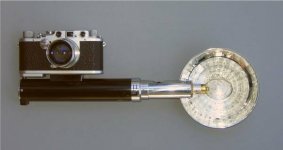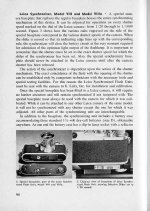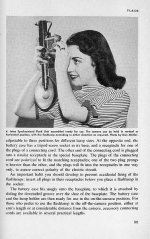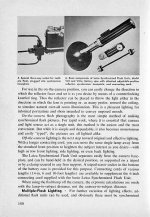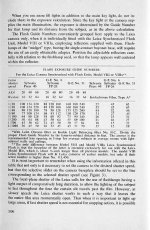Recently, I somehow convinced myself that I could not live without acquiring a IIIc version BUNOO baseplate and BLITZ flash for my pet early IIIc. 😀
From the way it appears to me, this works by using the downward travel of the shutter release shaft to contact and close a small switch in the baseplate, to complete the electrical circuit to the flashbulb.
Does anyone have an idea of what sort of shutter speeds might be useable with this with perhaps a 100 ISO film and #6 or #26 focal plane bulbs, or even (maybe??) a speedlight? Does anyone think some M5 or M25 bulbs might work? Were there ever any published guide numbers for the BLITZ / BUNOO?
This should be fun to use, I think.
Thanks!
Steve Busch
South Carolina, USA
Hey Steve,
Luddite Frank back with a few more bits & pieces of info....
Victor M. kindly provided some scans from a Leica instruction book, which are very helpful. And suggests that there were several variations to the Leica "baseplate flash sync" ....
The flash set-up I described in my first reply was mostly one of Leica's first "flashlamps", the box is marked "Blitzlicht-Ausloser"... this is listed in the 1936 Leica catalogue as "BTLOO", clamped to the end of the body (battery tube is in the vertical), shutter sync is achieved by a gizmo affixed to the top of the camera, using the shuter-speed dial to trip the flash (similar to the VACU).
The connection between the sync and the flashgun is via a cord with the Leica two-pronged plug. My BTLOO is missing the syncro attachment.
The black III that I was using this on had been updated with a standard PC socket, so I used a "PC to Leica two-prong" sync cord to connect the flash gun to the camera, and it seemed to work.
After digging around in my camera closet, I found my Leica baseplate sync & flashgun, as pictured in your post. Looks identical. My baseplate fits the first-generation Barnack bodies (Standard, I,II,III, and the a, b variants).
It is too short to fit my IIIf, and I presume too short to fit any of the -c Leicas (cast bodies).
As you suggested, the flash contact is made by the action of the shutter plunger activating a button contact in the baseplate, which has an adjusting screw. The base plate has to be calibrated to a specific camera body by Leica (or an approved service station), so that the flash fires at the appropriate time. ( This really functions on how far the shutter button is pressed before activating the baseplate contact; how that relates to the shutter mechanism is
"coincidence"... not be actual coordination of the shutter dial as is the case with the VACU or the internally-synced -f and -g Leicas.)
Now, back to Victor M and his info... the baseplate flash pictured in his booklet is thicker than the one Steve B and I have, and has an adjustable synchro slider on the back edge, AND, a two-prong sync cord socket on the baseplate itself, the earlier version placed the socket on the battery tube only.
The thicker baseplate jives with the picture of the eveready case with the "window" in the end and the flash clip on the bottom.
Apparently Victor's unit was indeed made for the -c and later cameras, still had to be calibrated to a specific camera body, but offered the ability to adjust the sync setting to use with any of the "instantaneous" shutter speeds - 1/20 thru 1/1000. (Just like setting the Black or Red sync dial on the -f or g- Leicas).
Still with me ? Now on to flash-bulbs and guide numbers...
For years, the "only" bulbs recommended for use with Focal plane shutters were "Long-Peak" bulbs, such as the #6, #26 and #31 or any bulb with the pre-fix "FP" - these bulbs have a long "burn-time", as much as 1/20 to 1/30 second, ensuring that the light endures long enough for complete exposure of the frame, often allowing the user to stop-down further, for greater DOF.
As flash bulbs developed, the burn-times and peak durations became shorter, as short as 1/200 second with the SM and SF bulbs, and midget bulbs like the M-2 and M-3.
In low-light conditions, exposure is not only a factor of the shutter speed, but also the duration of the instantaneous light source... so, even if your camera and BUNOO is properly synced for 1/30, if you are using a short-peak bulb like an SM or SF, the effect would be similar to a shutter speed of 1/200... because the burst of light is so brief, the frame may be unevenly exposed....
SO... if you want to use your BUNOO, the first step is getting it calibrated to the body you will be using it on... I'll bet somebody out there still has the equipment to do this. Once you get your baseplate synced, write the serial number of the camera body on the inside, in pencil, so you don't get mixed-up with other gear, if you're a multiple-Barnack family...
THEN, once "synced", you can see what bulbs are available... I have found that # 5 , #25, M-2, and M-3 and their blue-coated variants for color film seem to be the most plentiful (and cheapest). Try using the guide-numbers from the flash-bulb box...
I'm looking at a box of Sylvania 25 B bulbs, circa 1970, that recommends the following guide numbers for "Adjustable cameras X or M sync up to 1/30 ":
ASA: Guide #
10 to 12: 65
16 to 20: 80
25 to 32: 100
40 to 64: 150
80 - 125: 190
160 - 200: 260
320 - 500: 380
The difficulty I find with a lot of the period flash guides published by Leica, is they give guide numbers for specific films that are either long-vanished, and/or extremely slow-speed, by modern standards. AND recommend Focal-
Plane bulbs.
For what it's worth, the booklet for my Leica III-f recommends using 1/30 at sync setting 0 when using "strobe" (electronic flash)... so it would seem that 1/30 second is a good base-line for expirimentation with using modern short-peak bulbs with fixed-sync Leicas.
Modern high-speed fims (ASA 100 and faster) will probably tolerate use of short-peak bulbs better than the "regular" films of 50 - 75 years ago.
I believe Victor M. was planning a project for shooting school portraits using a screw-mount Leica with bulb-flash, so he may have a wealth of useful info for trying to use flashbulbs with modern films, etc, in the 21st Century.
Sorry this is so long... if you can track down a copy, "The Leica Manual", by Willard Morgan and Henry Lester, 10th ed. (1944) through 12th ed. (1953) have excellent info on flash photography with the Leica.... these turn-up on e-Bay ,and probably through Amazon...
If I can scan some of my print material, I will post it, and perhaps it can got to a reference area here at RFF...
Good luck with your BUNOO... now you 've got me wanting to get mine working !!!!
😎
Luddite Frank


